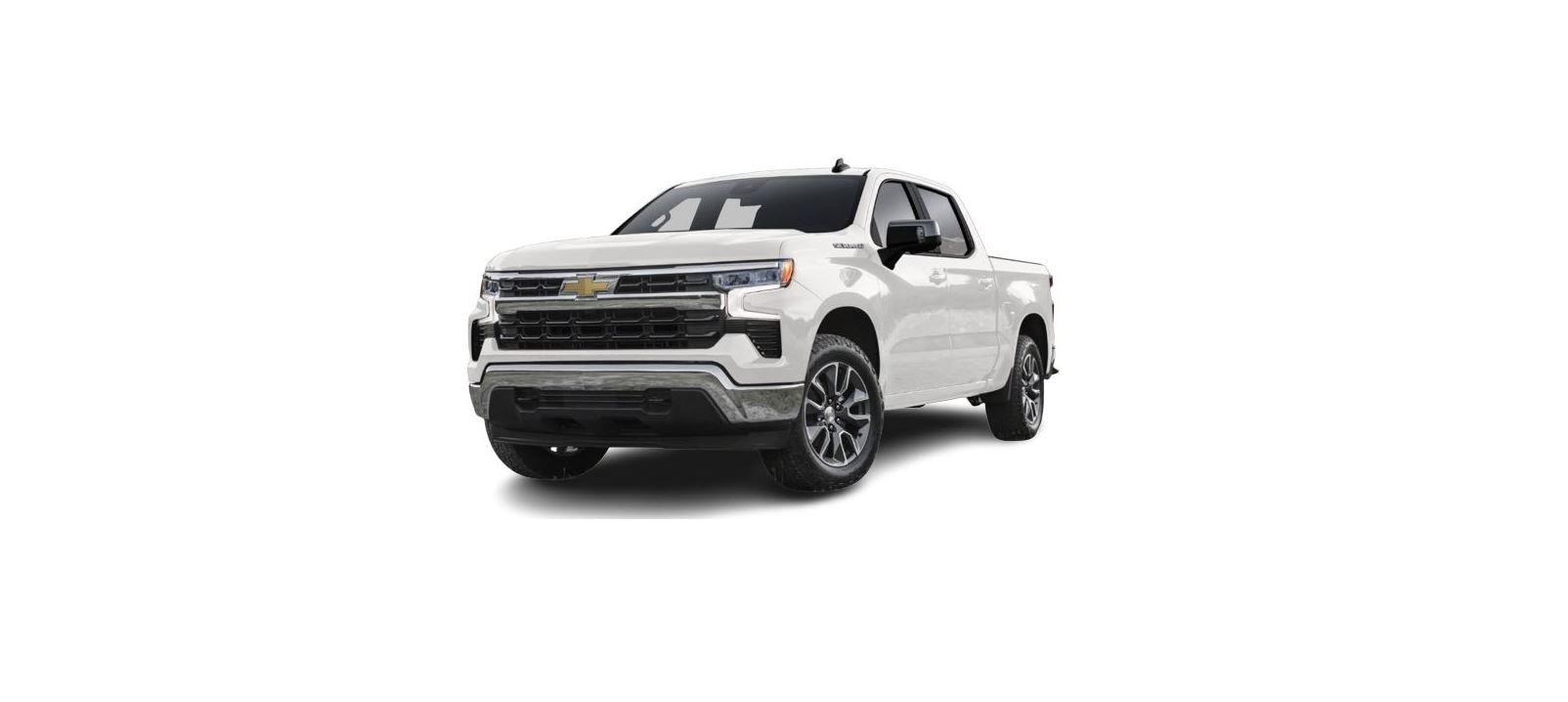2022 Chevrolet Silverado 1500 Vehicle Checks
 Vehicle Checks
Vehicle Checks
Doing Your Own Service Work
Warning
It can be dangerous to work on your vehicle if you do not have the proper knowledge, service manual, tools, or parts. Always follow the owner’s manual procedures and consult the service manual for your vehicle before doing any service work.
- If doing some of your own service work, use the proper service manual. It tells you much more about how to service the vehicle than this manual can. To order the proper service manual, see Publication Ordering Information 0 446.
- This vehicle has an airbag system. Before attempting to do your own service work, see Servicing the Airbag-Equipped Vehicle 66.
- If equipped with remote vehicle start, open the hood before performing any service work to prevent remote starting the vehicle accidentally. See Remote Vehicle Start 0 17.
- Keep a record with all parts receipts and list the mileage and the date of any service work performed. See Maintenance Records 434.
Caution
Even small amounts of contamination can cause damage to vehicle systems. Do not allow contaminants to contact the fluids, reservoir caps, or dipsticks.
Hood
Warning
For vehicles with auto engines stop/start, turn the vehicle off before opening the hood. If the vehicle is on, the engine will start when the hood is opened. You or others could be injured.
Warning
Components under the hood can get hot from running the engine. To help avoid the risk of burning unprotected skin, never touch these components until they have cooled, and always use a glove or towel to avoid direct skin contact. Clear any snow from the hood before opening.
To open the hood
- Pull the hood release lever with the isymbol. It is on the lower left side of the instrument panel
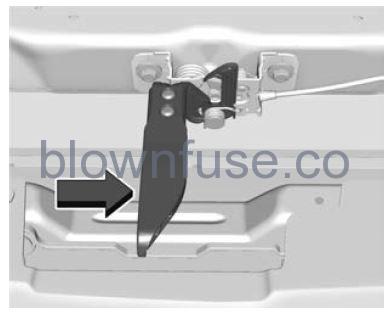 .
. - Go to the front of the vehicle and locate the secondary release lever under the front center of the hood. Push the secondary hood release lever to the right to release.
- After you have partially lifted the hood, the gas strut system will automatically lift the hood and hold it in the fullyopen position.
To close the hood
- efore closing the hood, be sure all filler caps are on properly, and all tools are removed.
- Pull the hood down until the strut system is no longer holding up the hood.
- Allow the hood to fall. Check to make sure the hood is latched completely. Repeat this process with additional force if necessary.
Warning
Do not drive the vehicle if the hood is not latched completely. The hood could open fully, block your vision, and cause a crash. You or others could be injured. Always close the hood completely before driving.
The Driver Information Center (DIC) will display a message if the hood is not fully closed, and the vehicle is moving. Stop and turn off the vehicle, check the hood for obstructions, and close the hood again. Check to see if the message still appears on the DIC.
Engine Compartment Overview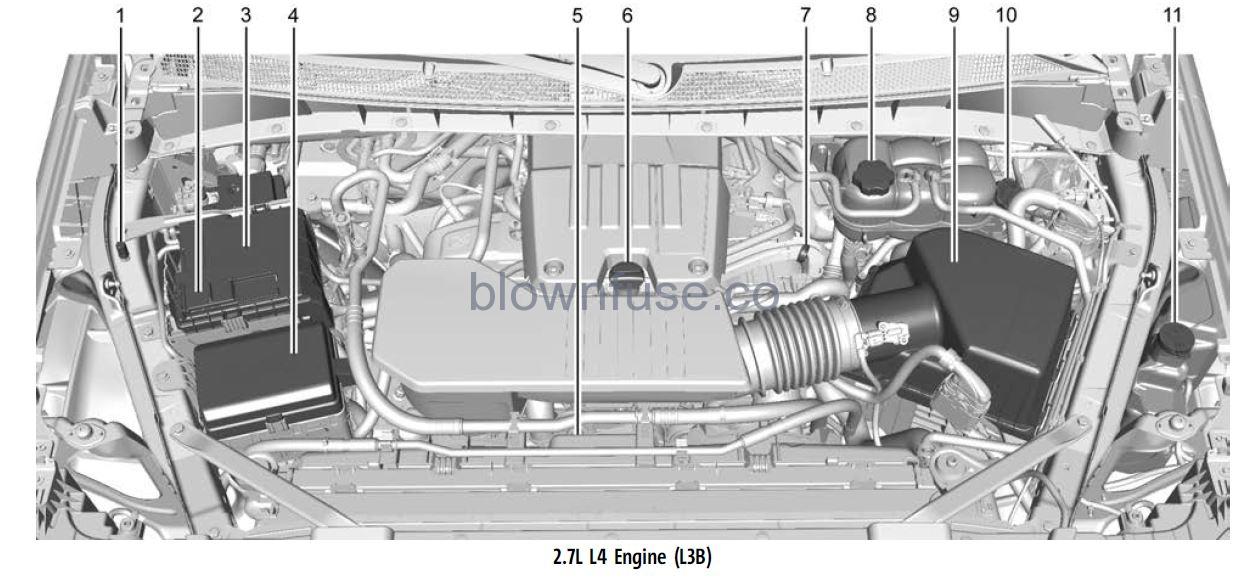
- Remote Negative (–) Location. See Jump Starting – North America 404.
- Positive (+) Terminal (Under Cover). See Jump Starting – North America 404.
- Battery – North America 357.
- Engine Compartment Fuse Block 367.
- Engine Cooling Fans (Out of View). SeeCooling System 348.
- Engine Oil Fill Cap. See “When to AddEngine Oil” under Engine Oil 344.
- Engine Oil Dipstick. See “Checking Engine Oil” under Engine Oil 344.
- Coolant Surge Tank and Pressure Cap. See Cooling System 348.
- Engine Air Cleaner/Filter 347.
- Brake Fluid Reservoir. See Brake Fluid 356.
- Windshield Washer Fluid Reservoir. See “Adding Washer Fluid” under Washer Fluid 354.
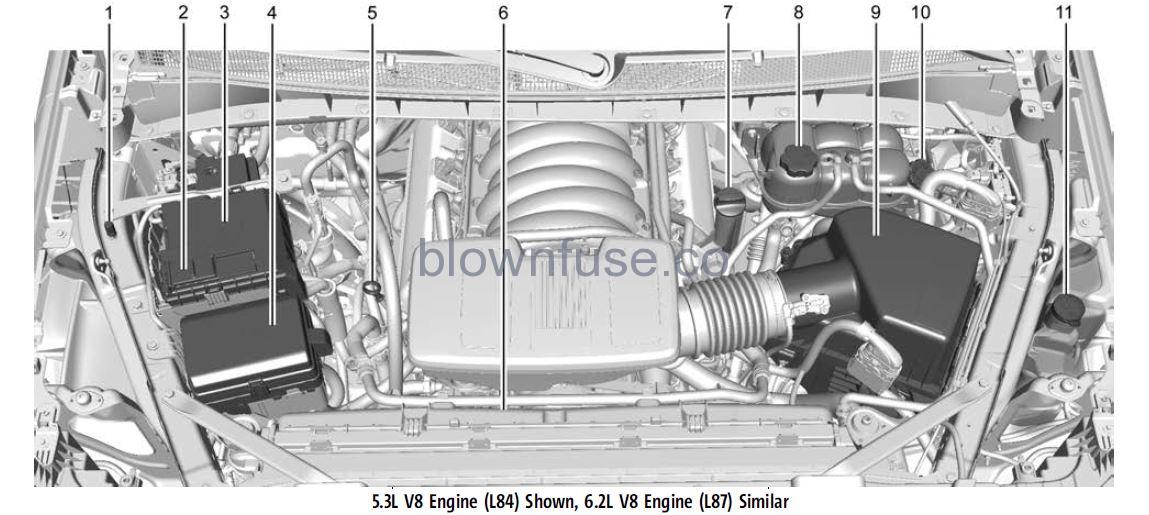
- Remote Negative (–) Location. See JumpStarting – North America 404.
- Positive (+) Terminal (Under Cover). See Jump Starting – North America 404.
- Battery – North America 357.
- Engine Compartment Fuse Block 367.
- Engine Oil Dipstick. See “Checking EngineOil” under Engine Oil 344.
- Engine Cooling Fans (Out of View). SeeCooling System 348.
- Engine Oil Fill Cap. See “When to Add Engine Oil” under Engine Oil 344.
- Coolant Surge Tank and Pressure Cap. See Cooling System 348.
- Engine Air Cleaner/Filter 347.
- Brake Fluid Reservoir. See Brake Fluid 356.
- Windshield Washer Fluid Reservoir. See “Adding Washer Fluid” under Washer Fluid 354.
Engine Oil
To ensure proper engine performance and long life, careful attention must be paid to engine oil. Following these simple, but important steps will help protect your investment:
- Use engine oil approved to the proper specification and of the proper viscosity grade. See “Selecting the Right Engine Oil” in this section.
- Check the engine oil level regularly and maintain the proper oil level. See “Checking Engine Oil” and “When to Add Engine Oil” in this section.
- Change the engine oil at the appropriate time. See Engine Oil Life System 0 346.
- Always dispose of engine oil properly. See “What to Do with Used Oil” in this section.
Checking Engine Oil
Check the engine oil level regularly, every 650 km (400 mi), especially prior to a long trip. The engine oil dipstick handle is a loop. See Engine Compartment Overview 0 341 for the location.
Warning
The engine oil dipstick handle may be hot; it could burn you. Use a towel or glove to touch the dipstick handle.
If a low oil Driver Information Center (DIC) message displays, check the oil level.
Follow these guidelines:
- To get an accurate reading, park the vehicle on level ground. Check the engine oil level after the engine has been off for at least two hours. Checking the engine oil level on steep grades or too soon after engine shutoff can result in incorrect readings. Accuracy improves when checking a cold engine prior to starting. Remove the dipstick and check the level.
- If unable to wait two hours, the engine must be off for at least 15 minutes if the engine is warm, or at least 30 minutes if the engine is not warm. Pull out the dipstick, wipe it with a clean paper towel or cloth, then push it back in all the way. Remove it again, keep the tip down, and check the level.
When to Add Engine Oil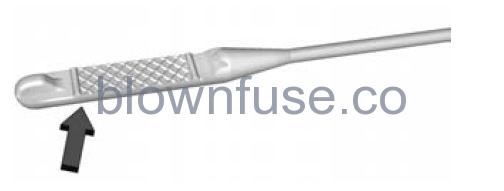
If the oil is below the cross-hatched area at the tip of the dipstick and the engine has been off for at least 15 minutes, add 1 L (1 qt) of the recommended oil and then recheck the level. See “Selecting the Right Engine Oil” later in this section for an explanation of what kind of oil to use. For engine oil crankcase capacity, see Capacities and Specifications 0 436.
Caution
Do not add too much oil. Oil levels above or below the acceptable operating range shown on the dipstick are harmful to the engine. If the oil level is above the operating range (i.e., the engine has so much oil that the oil level gets above the cross-hatched area that shows the proper operating range), the engine could be damaged. Drain the excess oil or limit driving of the vehicle, and seek a service professional to remove the excess oil.
See Engine Compartment Overview 0 341 for the location of the engine oil fill cap. Add enough oil to put the level somewhere in the proper operating range. Push the dipstick all the way back in when through.
Selecting the Right Engine Oil
Selecting the right engine oil depends on both the proper oil specification and viscosity grade. See Recommended Fluids and Lubricants 0 431.
Specification
Use full synthetic engine oils that meet the dexos1 specification. Engine oils that have been approved by GM as meeting the dexos1 specification are marked with the dexos1 approved logo.
Caution
Failure to use the recommended engine oil or equivalent can result in engine damage not covered by the vehicle
Viscosity Grade
- Use SAE 0W-20 viscosity grade engine oil for the 5.3L and 6.2L V8 engines.
- Use SAE 5W-30 viscosity grade engine oil for the 2.7L L4 engine. Cold Temperature Operation: In an area of extreme cold, where the temperature falls below −29 °C (−20 °F), an SAE 0W-30 oil may be used.
- An oil of this viscosity grade will provide easier cold starting for the engine at extremely low temperatures.
- When selecting an oil of the appropriate viscosity grade, it is recommended to select an oil of the correct specification. See “Specification” earlier in this section.
- Engine Oil Additives/Engine Oil Flushes Do not add anything to the oil. The recommended oils meeting the dexos1 specification are all that is needed for good performance and engine protection.
- Engine oil system flushes are not recommended and could cause engine damage not covered by the vehicle warranty.
What to Do with Used Oil
- Used engine oil contains certain elements that can be unhealthy for your skin and could even cause cancer. Do not let used oil stay on your skin for very long. Clean your skin and nails with soap and water, or a good hand cleaner. Wash or properly dispose of clothing or rags containing used engine oil. See the manufacturer’s warnings about the use and disposal of oil products.
- Used oil can be a threat to the environment.
- If you change your own oil, be sure to drain all the oil from the filter before disposal.
- Never dispose of oil by putting it in the trash or pouring it on the ground, into sewers, or into streams or bodies of water. Recycle it by taking it to a place that collects used oil.
Engine Oil Life System
When to Change Engine Oil
- This vehicle has a computer system that indicates when to change the engine oil and filter. This is based on a combination of factors which include engine revolutions, engine temperature, and miles driven. Based on driving conditions, the mileage at which an oil change is indicated can vary considerably. For the oil life system to work properly, the system must be reset every time the oil is changed.
- On some vehicles, when the system has calculated that oil life has been diminished, a CHANGE ENGINE OIL SOON message comes on to indicate that an oil change is necessary. Change the oil as soon as possible within the next 1 000 km (600 mi).
- It is possible that, if driving under the best conditions, the oil life system might indicate that an oil change is not necessary for up to a year. The engine oil and filter must be changed at least once a year and, at this time, the system must be reset. For vehicles without the CHANGE ENGINE OIL SOON message, an oil change is needed when the REMAINING OIL LIFE percentage is near 0%. Your dealer has trained service people who will perform this work and reset the system.
- It is also important to check the oil regularly over the course of an oil drain interval and keep it at the proper level.
- If the system is ever reset accidentally, the oil must be changed at 5 000 km (3,000 mi) since the last oil change. Remember to reset the oil life system whenever the oil is changed
How to Reset the Engine Oil Life System
Reset the system whenever the engine oil is changed so that the system can calculate the next engine oil change. Always reset the engine oil life to 100% after every oil change. It will not reset itself. To reset the engine oil life system:
- Display the oil life percentage on the DIC. See Driver Information Center (DIC) (Base Level) 0 123 or Driver Information Center (DIC) (Uplevel) 125.
- Press the thumbwheel on the steering wheel, or the trip odometer reset stem if the vehicle does not have DIC controls, for several seconds. When the confirmation message displays, select YES. The oil life will change to 100%.
The oil life system can also be reset as follows:
- Display the oil life percentage on the DIC. See Driver Information Center (DIC) (Base Level) 0 123 or Driver Information Center (DIC) (Uplevel) 125.
- Fully press the accelerator pedal slowly three times within five seconds.
- If the display changes to 100%, the system is reset.
If the vehicle has a CHANGE ENGINE OIL SOON message and it comes back on when the vehicle is started and/or the oil life percentage is near 0%, the engine oil life system has not been reset. Repeat the procedure.
Automatic Transmission Fluid
When to Check and Change Automatic Transmission Fluid
It is usually not necessary to check the transmission fluid level. The only reason for the fluid loss is a transmission leak or overheated transmission. This vehicle is not equipped with a transmission fluid level dipstick. There is a special procedure for checking and changing the transmission fluid in these vehicles. Because this procedure is difficult, this should be done at the dealer. Contact the dealer for additional information or the procedure can be found in the service manual. See Publication Ordering Information 446. Change the fluid and filter at the scheduled maintenance intervals listed in Maintenance Schedule 0 422. Be sure to use the transmission fluid listed in Recommended Fluids and Lubricants 431.
Engine Air Filter Life System
If equipped, this feature provides the engine air filter’s remaining life and the best timing for a change. The timing to change an engine air filter depends on driving and environmental conditions.
When to Change the Engine Air Filter
- When the Driver Information Center (DIC) displays a message to replace the engine air filter at the next oil change, follow this timing.
- When the DIC displays a message to replace the engine air filter soon, replace the engine air filter at the earliest convenience.
- The system must be reset after the engine air filter is changed.
- If the DIC displays a message to check the engine air filter system, see your dealer.
How to Reset the Engine Air Filter Life System
To reset:
- Place the vehicle in P (Park).
- Display the Air Filter Life on the DIC. See Driver Information Center (DIC) (Base Level) 0 123 or Driver Information Center (DIC) (Uplevel) 125.
- Press T on the steering wheel, or press the trip odometer reset stem if the vehicle does not have DIC controls, to move to the Reset/Disable display area. Select Reset then press the thumbwheel or press the reset stem for several seconds.
- Press the thumbwheel or the reset stem to confirm the reset.
Engine Air Cleaner/Filter
The engine air cleaner/filter is on the driver’s side of the engine compartment. See Engine Compartment Overview 0 341.
When to Inspect the Engine Air Cleaner/Filter
If the vehicle is not equipped with the engine air filter life system see Maintenance Schedule 0 422 for intervals on inspecting and replacing the engine air cleaner filter.
How to Inspect/Replace the Engine Air Cleaner/Filter
Do not start or run the engine with the engine air cleaner/filter housing open. Before removing the engine air cleaner/ filter, clear any dirt and debris away from the engine air cleaner/filter housing and nearby components. Remove the engine air cleaner/filter. Lightly tap and shake the engine air cleaner/filter (away from the vehicle), to release loose dust and dirt. Inspect the engine air cleaner/filter for damage; replace if damaged. Do not clean the engine air cleaner/filter or components with water or compressed air. To inspect or replace the engine air cleaner/ filter:
- Air Duct Clamp
- Screws
- Locate the air cleaner/filter assembly. See Engine Compartment Overview 0 341.
- Disconnect the outlet duct by loosening the air duct clamp (1).
- Remove the three screws on top of the cover of the housing, then slide and lift the cover.
- Lift and remove the engine air cleaner/ filter.
- Warning If part replacement is necessary, the partmust be replaced with one of the samepart number or with an equivalent part.Use of a replacement part without thesame fit, form, and function may resultin personal injury or damage to the vehicle.
- Lightly tap and shake the engine air cleaner/filter, away from the vehicle, to release loose dust and dirt. Replace the engine air filter if damaged.
- Reverse Steps 2–5 to reinstall the engine air cleaner/filter cover housing.
- If equipped, reset the engine air filter life system after replacing the engine air filter. See Engine Air Filter Life System 0 347.
Warning
Operating the engine with the air cleaner/filter off can cause you or others to be burned. Use caution when working on the engine. Do not start the engine or drive the vehicle with the air cleaner/ filter off, as flames may be present if the engine backfires.
Caution
If the air cleaner/filter is off, dirt can easily get into the engine, which could damage it. Always have the air cleaner/ filter in place when driving.
Cooling System
If the vehicle has the Duramax diesel engine, see the Duramax diesel supplement. The cooling system allows the engine to maintain the correct working temperature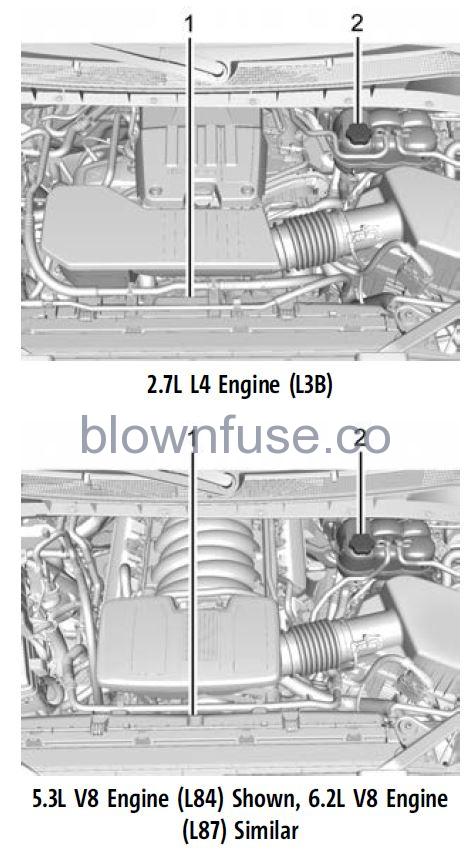
- Engine Electric Cooling Fans (Out of View)
- Coolant Surge Tank and Pressure Cap
Warning
An underhood electric fan can start up even when the engine is not running and can cause injury. Keep hands, clothing, and tools away from any underhood electric fan.
Warning
Do not touch heater, radiator, a/c pipes or hoses, or other engine parts. They can be very hot and can burn you. Do not run the engine if there is a leak; all coolant could leak out. That could cause an engine fire and can burn you. Fix any leak before driving the vehicle.
Engine Coolant
The cooling system in the vehicle is filled with DEX-COOL engine coolant. This coolant is designed to remain in the vehicle for 5 years or 240 000 km (150,000 mi), whichever occurs first. The following explains the cooling system and how to check and add coolant when it is low. If there is a problem with engine overheating, see Engine Overheating 0 352.
What to Use
Warning: Plain water, or other liquids such as alcohol, can boil before the proper coolant mixture will. With plain water or the wrong mixture, the engine could get too hot but there would not be an overheat warning. The engine could catch fire and you or others could be burned.
Use a 50/50 mixture of clean, drinkable water and DEX-COOL coolant. This mixture:
- Gives freezing protection down to −37 °C (−34 °F), the outside temperature.
- Gives boiling protection up to 129 °C (265 °F), and engine temperature.
- Protects against rust and corrosion.
- Will not damage aluminum parts.
- Helps keep the proper engine temperature.
Caution
Do not use anything other than a mix ofDEX-COOL coolant that meets GM Standard GMW3420 and clean, drinkable water. Anything else can cause damage to the engine cooling system and the vehicle, which would not be covered by the vehicle warranty.
Never dispose of engine coolant by putting it in the trash, or by pouring it on the ground, or into sewers, streams, or bodies of water. Has the coolant changed by an authorized service center, familiar with legal requirements regarding used coolant disposal? This will help protect the environment and your health.
Checking Coolant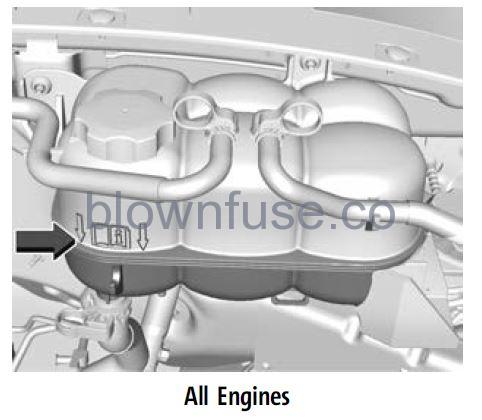
The coolant surge tank is in the engine compartment on the driver’s side of the vehicle. See Engine Compartment Overview 0 341. The vehicle must be on a level surface when checking the coolant level Check to see if coolant is visible in the coolant surge tank. If the coolant inside the coolant surge tank is boiling, wait until it cools down. The coolant level should be at or above the indicated mark. If it is not, there may be a leak in the cooling system. If coolant is visible but the coolant level is not at or above the indicated mark, see the following sections on how to add coolant to the coolant surge tank following.
Automatic Coolant Service Fill Instructions (L3B Engine)
This feature assists in filling and removing air from the cooling system after the service of components or when coolant is added after being too low.
To activate the fill and air removal process:
- Remove the coolant surge tank pressure cap when the cooling system, including the coolant surge tank pressure cap and upper radiator hose, is no longer hot. Turn the pressure cap; slowly counterclockwise about one full turn. If a hiss is heard, wait for that to stop A hiss means there is still some pressure left.
- Keep turning the pressure cap slowly, and remove it.
- Fill the coolant surge tank with the proper mixture to the indicated mark.
- Connect the vehicle to a battery charger.
- Set the ignition to service mode, see Ignition Positions 217.
- Turn off the air conditioning.
- Set the parking brake.
- At the same time, press the accelerator and the brake for automatic vehicles for two seconds, then release.
- Listen for pump activation and movement of the control valves while watching the level of the coolant in the surge tank. Add fluid as the level drops below the indicated mark on the surge tank. Allow 15 minutes for the fill and air removal process to complete.
- Reinstall the surge tank cap.
If the tank empties, turn the ignition off, allow the Electronic Control Module (ECM) to go to sleep, about two minutes, refill to the indicated mark, and repeat Steps 5–9.
How to Add Coolant to the Coolant Surge Tank for Gasoline Engines Except L3B
If the vehicle has a diesel engine, see “Cooling System” in the Duramax diesel supplement for the proper coolant fill procedure.
Warning
Spilling coolant on hot engine parts can burn you. Coolant contains ethylene glycol and it will burn if the engine parts are hot enough.
Warning
Plain water, or other liquids such as alcohol, can boil before the propercoolant mixture will. With plain water or the wrong mixture, the engine could get too hot but there would not be an overheat warning. The engine could catch fire and you or others could be burned.
Warning
Steam and scalding liquids from a hot cooling system are under pressure. Turning the pressure cap, even a little, can cause them to come out at high speed and you could be burned. Never turn the cap when the cooling system, including the pressure cap, is hot. Wait for the cooling system and pressure cap to cool.
Caution
Failure to follow the specific coolant fill procedure could cause the engine to overheat and could cause system damage. If coolant is not visible in the surge tank, contact your dealer.
If no coolant is visible in the surge tank, add coolant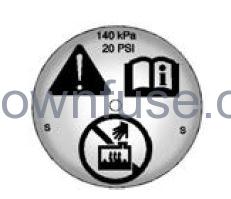
- Remove the coolant surge tank pressure cap when the cooling system, including the coolant surge tank pressure cap and upper radiator hose, is no longer hot. Turn the pressure cap slowly counterclockwise about one full turn. If a hiss is heard, wait for that to stop. A hiss means there is still some pressure left.
- Keep turning the pressure cap slowly, and remove it.
- Fill the coolant surge tank with the proper mixture to the full cold mark.
- With the coolant surge tank pressure cap off, start the engine and let it run until the engine coolant temperature gauge indicates approximately 90 °C (195 °F). By this time, the coolant level inside the coolant surge tank may be lower. If the level is lower, add more of the proper mixture to the coolant surge tank until the level reaches the indicated mark.
- Replace the pressure cap tightly.
- Verify the coolant level after the engine is shut off and the coolant is cold. If necessary, repeat the coolant fill procedure Steps 1–6.
Caution
If the pressure cap is not tightly installed, coolant loss and engine damage may occur. Be sure the cap is properly and tightly secured.
Engine Overheating
If the vehicle has the Duramax diesel engine, see the Duramax diesel supplement.
Caution
Do not run the engine if there is a leak in the engine cooling system. This can cause a loss of all coolant and can damage the system and vehicle. Have any leaks fixed right away.
- The vehicle has several indicators to warn of engine overheating.
- There is a coolant temperature gauge in the vehicle’s instrument cluster. See Engine Coolant Temperature Gauge 0 110.
- In addition, there are ENGINE OVERHEATED STOP ENGINE, ENGINE OVERHEATED IDLE ENGINE, and ENGINE POWER IS REDUCED messages in the Driver Information Center (DIC).
- If the decision is made not to lift the hood when this warning appears, get service help right away. See Roadside Assistance Program 442.
- If the decision is made to lift the hood, make sure the vehicle is parked on a level surface.
2.7L L4, 5.3L V8, and 6.2L V8 Engines
- Check to see if the engine cooling fans are running. If the engine is overheating, the fans should be running. If they are not, do not continue to run the engine and have the vehicle serviced.
- If the engine or transmission detects an impending hot fluid condition, then the transmission may force upshifts to limit temperatures. Downshifts may also be prevented in this instance. Normal operation may continue unless the display indicates there is a hot condition and the engine should be idled.
If Steam is Coming from the Engine Compartment
Warning
Steam and scalding liquids from a hot cooling system are under pressure. Turning the pressure cap, even a little, can cause them to come out at high speed and you could be burned. Never turn the cap when the cooling system, including the pressure cap, is hot. Wait for the cooling system and pressure cap to cool.
If No Steam is Coming from the Engine Compartment
The ENGINE OVERHEATED STOP ENGINE or the ENGINE OVERHEATED IDLE ENGINE message, along with a low coolant condition, can indicate a serious problem. The 2.7L L4 engine will shut down automatically if the ENGINE OVERHEATED STOP ENGINE message displays. If there is an engine overheat warning, but no steam is seen or heard, the problem may not be too serious. Sometimes the engine can get a little too hot when the vehicle:
- Climbs a long hill on a hot day.
- Stops after high-speed driving.
- Idles for long periods in traffic.
- Tows a trailer; see Trailer Towing 309.
If the ENGINE OVERHEATED STOP ENGINE or the ENGINE OVERHEATED IDLE ENGINE message appears with no sign of steam, try this for a minute or so:
- Turn the air conditioning off.
- Turn the heater on to the highest temperature and to the highest fan speed. Open the windows as necessary.
- When it is safe to do so, pull off the road, shift to P (Park) or N (Neutral) and let the engine idle.
- If the temperature overheats gauge is no longer in the overheat zone or an overheat warning no longer displays, the vehicle can be driven. Continue to drive the vehicle slowly for about 10 minutes. Keep a safe vehicle distance from the vehicle in front.
- If the warning does not come back on, continue to drive normally and have the cooling system checked for proper fill and function.
- If the warning continues, pull over, stop, and park the vehicle right away.
- If there is still no sign of steam and the vehicle is equipped with an engine-driven cooling fan, push down the accelerator until the engine speed is about twice as fast asnormal idle speed for at least five minutes while the vehicle is parked. If the warning is still there, turn off the engine and get everyone out of the vehicle until it cools down.
- If there is no sign of steam, idle the engine for five minutes while parked. If the warning is still displayed, turn off the engine until it cools down.
Overheated Engine Protection
Operating Mode
- If an overheated engine condition exists and the ENGINE POWER IS REDUCED message displays, an overheat protection mode that alternates firing groups of cylinders helps toprevent engine damage.
- In this mode, a loss in power and engine performance will be noticed. This operating mode allows the vehicle to be driven to a safe place in an emergency. Driving extended distances and/ or towing a trailer in the overheat protection mode should be avoided.
- If the engine or transmission detects an impending hot fluid condition, then the transmission may force upshifts to limittemperatures. Downshifts may also be prevented in this instance. Normal operation may continue unless the display indicates there is a hot condition and the engine should be idled.
Caution
After driving in the overheated engine protection operating mode, the engine oil will be severely degraded. Any repairs performed before the engine is cool may cause engine damage. Allow the engine to cool before attempting any repair. Repair the cause of coolant loss, change the oil, and reset the oil life system. SeeEngine Oil 344.
Engine Fan
If the vehicle has the Duramax diesel engine, see the Duramax diesel supplement. The vehicle has an electric cooling fan(s). The fans may be heard spinning at low speed during most everyday driving. The fans may turn off if no cooling is required. Under heavy vehicle loading, trailer towing, high outside temperatures, or operation of the air conditioning system, the fans may change to high speed and an increase in fan noise may be heard. This is normal and indicates that the cooling system is functioning properly. The fans will change to low speed when additional cooling is no longer required. The electric engine cooling fans may run after the engine has been turned off. This is normal and no service is required.
Washer Fluid
What to Use
When windshield washer fluid needs to be added, be sure to read the manufacturer’s instructions before use. Use a fluid that has sufficient protection against freezing in an area where the temperature may fall below freezing.
Adding Washer Fluid
The vehicle has a low washer fluid message on the DIC that comes on when the washer fluid is low. The message is displayed for 15 seconds at the start of each ignition cycle. When the WASHER FLUID LOW ADD FLUID message displays, washer fluid will need to be added to the windshield washer fluid reservoir.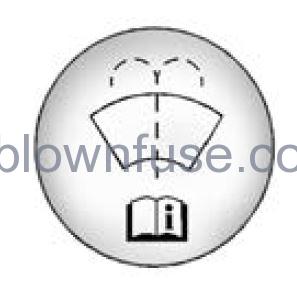
Open the cap with the washer symbol on it. Add washer fluid until the tank is full. See Engine Compartment Overview 0 341 for reservoir location.
Caution
- Do not use a washer fluid that contains any type of water repellent coating. This can cause the wiper blades to chatter or skip.
- Do not use engine coolant (antifreeze) in the windshield washer. It can damage the windshield washer system and paint.
- Do not mix water with ready-to-use washer fluid. Water can cause the solution to freeze and damage the washer fluid tank and other parts of the washer system.
- When using concentrated washer fluid, follow the manufacturer’s instructions for adding water.
- Fill the washer fluid tank only three-quarters full when it is very cold. This allows for fluid expansion if freezing occurs, which could damage the tank if it is completely full.
Brakes
Disc brake linings have built-in wear indicators that make a high-pitched warning sound when the brake linings are worn and new linings are needed. The sound can come and go or can be heard all the time when the vehicle is moving, except when applying the brake pedal firmly.
Warning
The brake wear warning sound means that soon the brakes will not work well. That could lead to a crash. When the brake wear warning sound is heard, have the vehicle serviced.
Caution
Continuing to drive with worn-out brakelinings could result in costly brake repairs.
Some driving conditions or climates cancause a brake squeal when the brakes are first applied, clearing up following several applications. This does not mean something is wrong with the brakes. Properly torqued wheel nuts are necessary to help prevent brake pulsation. When tires are rotated, inspect brake linings for wear and evenly tighten wheel nuts in the proper sequence to torque specifications. See Capacities and Specifications 436. Brake pads should be replaced as complete axle sets.
See your dealer if the brake pedal does not return to normal height, or if there is a rapid increase in pedal travel. This could be a sign that brake service may be required.
Replacing Brake System Parts
Always replace brake system parts with new, approved replacement parts. If this is not done, the brakes may not work properly. The braking performance can change in many ways if the wrong brake parts are installed or if parts are improperly installed.
Brake Pad Life System
When to Change Brake Pads
- This vehicle has a system that estimates the remaining life of the front and rear brake pads. Brake pad life is displayed in the Driver Information Center (DIC), along with a percentage for each axle. The system must be reset every time the brake pads are changed.
- When the system has determined that the brake pads need to be replaced, a message will display, which may include mileage remaining.
- Brake pads should always be replaced as complete axle sets.
How to Reset the Brake Pad Life System
The system will automatically detect when significantly worn brake pads are replaced. When the ignition is turned on after new pads and wear sensors are installed, a message will display. Follow the prompts to reset the system.
The brake pad life system can also be manually reset:
- Display Brake Pad Life on the DIC. See Driver Information Center (DIC) (Base Level) 0 123 or Driver Information Center (DIC) (Uplevel) 125.
- Press the thumbwheel or the trip odometer reset stem if the vehicle does not have DIC buttons. Select front or rear pads as appropriate.
- Select YES on the confirmation message, or press the trip odometer reset stem on a base level DIC. Repeat for pads on the other axle if they were also replaced.
How to Disable the Brake Pad Life System
The brake pad life system can be turned off. This may be necessary if aftermarket brake pads without wear sensors are installed. When the system is turned off, the front and rear brake pad life percentages will not display. However, the built-in wear indicators that make a high-pitched warning sound when the brake pads are worn can still determine when the pads should be replaced. See Brakes 0 354.
To turn off the brake pad life system:
- Display Brake Pad Life on the DIC. See Driver Information Center (DIC) (Base Level) 0 123 or Driver Information Center (DIC) (Uplevel) 125.
- Select DISABLE.
To turn the brake pad life system back on, follow the above steps but select ENABLE in Step 2.
Brake Fluid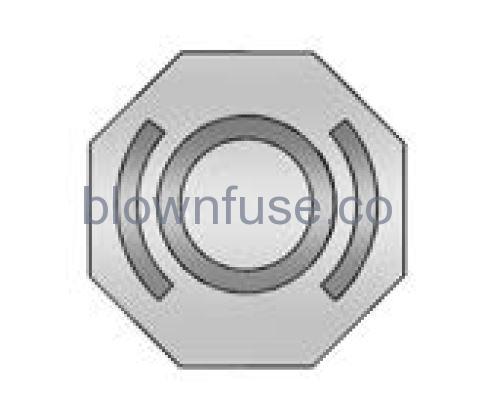
The brake master cylinder reservoir is filled with GM-approved DOT 4 brake fluid as indicated on the reservoir cap. See Engine Compartment Overview 0 341 for the location of the reservoir There are only two reasons why the brake fluid level in the reservoir may go down:
- Normal brake lining wear. When new linings are installed, the fluid level goes back up.
- A fluid leak in the brake hydraulic system. Have the brake hydraulic system fixed. With a leak, the brakes will not work well.
Always clean the brake fluid reservoir cap and the area around the cap before removing it. Do not top off the brake fluid. Adding fluid does not correct a leak. If the fluid is added when the linings are worn, there will be too much fluid when new brake linings are installed. Add or remove fluid, as necessary, only when work is done on the brake hydraulic system.
Warning
If too much brake fluid is added, it can spill on the engine and burn, if the engine is hot enough. You or others could be burned, and the vehicle could be damaged. Add brake fluid only when work is done on the brake hydraulic system.
When the brake fluid falls to a low level, the brake warning light comes on. See Brake System Warning Light 0 116. Brake fluid absorbs water over time which degrades the effectiveness of the brake fluid. Replace brake fluid at the specified intervals to prevent increased stopping distance. See Maintenance Schedule 0 422
What to Add
Use only GM-approved DOT 4 brake fluid from a clean, sealed container. See Recommended Fluids and Lubricants 0 431.
Warning
The wrong or contaminated brake fluid could result in damage to the brake system. This could result in the loss of braking leading to a possible injury. Always use the proper GM-approved brake fluid.
Caution
If the brake fluid is spilled on the vehicle’s painted surfaces, the paint finish can be damaged. Immediately wash off any painted surface
Battery – North America
The original equipment battery is maintenance-free. Do not remove the cap and do not add fluid. Refer to the replacement number shown on the original battery label when a new battery is needed. See Engine Compartment Overview 0 341 for battery location.
Stop/Start System
Vehicles equipped with a 2.7L L3B, , 5.3L L84, or 6.2L L87 are equipped with a Stop/Start system to shut off the engine to help conserve fuel. See Stop/Start System 0 220. Vehicles with the Stop/Start system have an Absorbed Glass Mat (AGM) 12-volt battery. Installation of a standard 12-volt battery will result in reduced 12-volt battery life. When using a 12-volt battery charger on the 12-volt AGM battery, some chargers have an AGM battery setting on the charger. If available, use the AGM setting on the charger to limit the charge voltage to 14.8 volts. Follow the charger manufacturer’s instruction
WARNING: Battery posts, terminals and related accessories can expose you to chemicals including lead and lead compounds, which are known to the State of California to cause cancer and birth defects or other reproductive harm. Wash hands after handling. For more information go towww.P65Warnings.ca.gov.
See the warning on the back cover.
Vehicle Storage
Warning
Batteries have acid that can burn you and gas that can explode. You can be badly hurt if you are not careful. Always wear eye protection. See Jump Starting – North America 0 404 for tips on working around a battery without getting hurt.
- Infrequent Usage: Remove the black, negative (−) cable from the battery to keep the battery from running down.
- Extended Storage: Remove the black, negative (−) cable from the battery or use a battery trickle charger.
Negative Battery Cable Disconnection
Warning
Before disconnecting the negative battery cable, turn off all features, turn the ignition off, and remove the key, if equipped, from the vehicle. If this is not done, you or others could be injured, and the vehicle could be damaged.
Caution
If the battery is disconnected with the ignition on or the vehicle in Retained Accessory Power (RAP), the OnStar backup battery will be permanently discharged and will need to be replaced.
- Make sure the lamps, features, and accessories are turned off.
- Turn the ignition off and remove the key, if equipped.
For vehicles equipped with the Stop/Start system 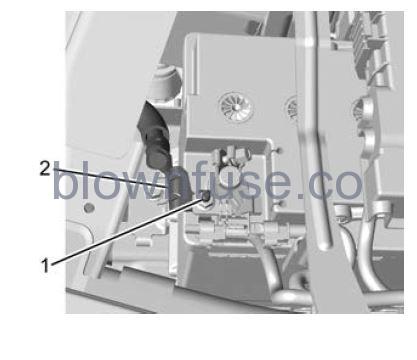
- Loosen and remove the negative battery cable nut (1) at the battery sensor connection.
- Remove the negative battery cable (2)from the battery sensor stud.
- Cover the negative battery cable terminal, battery sensor stud, and negative battery post with a non-conductive material to prevent any contact with the negative battery cable.
For vehicles not equipped with the Stop/ Start system: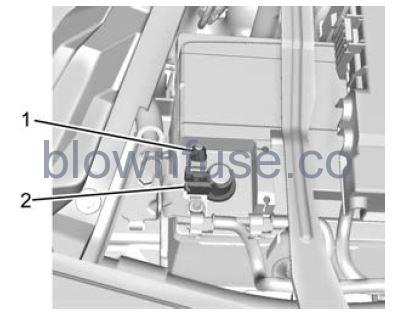
- Loosen the negative battery cable nut (1).
- Remove the negative battery cable clamp (2) from the negative battery post.
- Cover the negative battery cable clamp, and negative battery post with a non-conductive material to prevent any contact with the negative battery cable.
Negative Battery Cable Reconnection
Caution
When reconnecting the battery:
- Use the original nut from the vehicle to secure the negative battery cable. Do not use a different nut. If you need a replacement nut, see your dealer.
- Tighten the nut with a hand tool. Do not use an impact wrench or power tools to tighten the nut. The vehicle could be damaged if these guidelines are not followed.
Caution
Do not use paints, lubricants, or corrosion inhibitors on the nut that secures the negative battery cable to the vehicle. This could damage the vehicle.
For vehicles equipped with the Stop/Start system:
- Install the negative battery cable to the battery sensor stud.
- Install the negative battery cable nut to the battery sensor stud and tighten.
- Turn the ignition on.
For vehicles not equipped with the Stop/ Start system:
- Install the negative battery cable clamp to the negative battery post.
- Tighten the negative battery cable nut.
- Turn the ignition on.
Four-Wheel Drive
Transfer Case
When to Check Lubricant
Refer to Maintenance Schedule 0 422 to determine when to check the lubricant.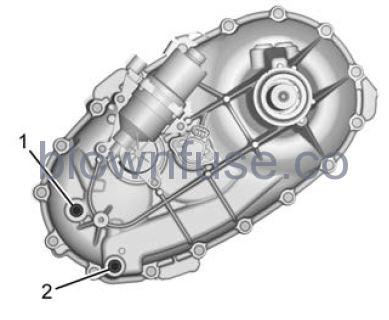
- Fill Plug
- Drain Plug
To get an accurate reading, the vehicle should be on a level surface. If the level is below the bottom of the fill plug (1) hole, located on the transfer case, some lubricant will need to be added. Add enough lubricant to raise the level to the bottom of the fill plug (1) hole. Use care not to overtighten the plug.
When to Change Lubricant
Refer to Maintenance Schedule 0 422 to determine how often to change the lubricant.
What to Use
Refer to Recommended Fluids and Lubricants 0 431 to determine what kind of lubricant to use.
Front Axle
When to Check Lubricant
- It is not necessary to regularly check the front axle fluid unless a leak is suspected or an unusual noise is heard. A fluid loss could indicate a problem. Has it been inspected and repaired? This service can be complex. See your dealer.
- Do not directly power wash the transfer case and/or front/rear axle output seals. High-pressure water can overcome the seals and contaminate the fluid. Contaminated fluid will decrease the life of the transfercase and/or drive axles and should be replaced.
Rear Axle
When to Check Lubricant
It is not necessary to regularly check the rear axle fluid unless a leak is suspected or an unusual noise is heard. A fluid loss could indicate a problem. Has it been inspected and repaired? This service can be complex. See your dealer. Do not directly power wash the transfer case and/or front/rear axle output seals. High-pressure water can overcome the seals and contaminate the fluid. Contaminated fluid will decrease the life of the transfer case and/or drive axles and should be replaced.
Automatic Transmission Shift Lock Control Function Check (Mechanical Shifter)
Warning
When you are doing this inspection, the vehicle could move suddenly. If the vehicle moves, you or others could be injured.
- Before starting this check, be sure there is enough room around the vehicle. It should be parked on a level surface.
- Apply the parking brake. Be ready to apply the regular brake immediately if the vehicle begins to move.
- With the engine off, turn the ignition on, but do not start the engine. Without applying the regular brake, try to move the shift lever out of P (Park) with normal effort. If the shift lever moves out of P (Park), contact your dealer for service.
Park Brake and P (Park) Mechanism Check
Warning
When you are doing this check, the vehicle could begin to move. You or others could be injured and property could be damaged. Make sure there is room in front of the vehicle in case it begins to roll. Be ready to apply the regular brake at once should the vehicle begin to move.
Park on a fairly steep hill, with the vehicle facing downhill. Keeping your foot on the regular brake, set the parking brake.
- To check the parking brake’s holding ability: With the engine running and the transmission in N (Neutral), slowly remove foot pressure from the regular brake pedal. Do this until the vehicle is held by the parking brake only.
- To check the P (Park) mechanism’s holding ability: With the engine running, shift to P (Park). Then release the parking brake followed by the regular brake. Contact your dealer if service is required
Wiper Blade Replacement
- Windshield wiper blades should be replaced periodically. See Maintenance Schedule 422.
- Replacement blades come in different types and are removed in different ways. For proper type and length, see Maintenance Replacement Parts 432.
Caution
Allowing the wiper arm to touch the windshield when no wiper blade is installed could damage the windshield. Any damage that occurs would not be covered by the vehicle warranty. Do not allow the wiper arm to touch the windshield.
Front Wiper Blade Replacement
To replace the wiper blade:
- Pull the wiper assembly away from the windshield.
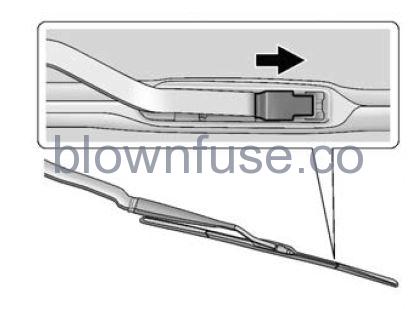
- Lift up on the latch in the middle of the wiper blade where the wiper arm attaches.
- With the latch open, pull the wiper blade down toward the windshield far enough to release it from the J-hooked end of the wiper arm.
- Remove the wiper blade.
- Reverse Steps 1–3 for wiper blade replacement.
Glass Replacement
If the windshield or front side glass must be replaced, see your dealer to determine the correct replacement glass.
Windshield Replacement
HUD System
If equipped, the windshield is part of the HUD system. If the windshield must be replaced, get one that is designed for HUD or the HUD image may look out of focus.
Driver Assistance Systems
If the windshield needs to be replaced and the vehicle is equipped with a front camera sensor for the Driver Assistance Systems, a GM replacement windshield is recommended. The replacement windshield must be installed according to GM specifications for proper alignment. If it is not, these systems may not work properly, they may display messages, or they may not work at all. See your dealer for proper windshield replacement.
Gas Strut(s)
This vehicle is equipped with gas strut(s) to provide assistance in lifting and holding open the hood/trunk/liftgate system in fully open position.
Warning
If the gas struts that hold open the hood, trunk, and/or liftgate fail, you or others could be seriously injured. Take the vehicle to your dealer for service immediately. Visually inspect the gas struts for signs of wear, cracks, or other damage periodically. Check to make sure the hood/trunk/liftgate is held open with enough force. If struts are failing to hold the hood/trunk/liftgate, do not operate. Have the vehicle serviced.
Caution
Do not apply tape or hang any objects from gas struts. Also do not push down or pull on gas struts. This may cause damage to the vehicle.
See Maintenance Schedule 422.

